Shah Jahan
Shihab-ud-Din Muhammad Khurram (5 January 1592 – 22 January 1666), better known by his regnal name Shah Jahan I (Persian pronunciation: [ʃɑːh d͡ʒahɑːn]; lit. 'King of the World'), was the fifth emperor of the Mughal Empire, reigning from January 1628 until July 1658. Under his emperorship, the Mughals reached the peak of their architectural achievements and cultural glory.
| Shah Jahan I | |||||||||||||
|---|---|---|---|---|---|---|---|---|---|---|---|---|---|
| |||||||||||||
.jpg.webp) Portrait of Shah Jahan, c. 1630 | |||||||||||||
| 5th Emperor of the Mughal Empire | |||||||||||||
| Reign | 19 January 1628 –31 July 1658[1] | ||||||||||||
| Coronation | 14 February 1628,[2] Agra | ||||||||||||
| Predecessor | Shahriyar (de facto) Jahangir I | ||||||||||||
| Successor | Alamgir I | ||||||||||||
| Born | Khurram[3] 5 January 1592 Lahore Fort, Lahore, Mughal Empire | ||||||||||||
| Died | 22 January 1666 (aged 74) Agra Fort, Agra, Mughal Empire | ||||||||||||
| Burial | |||||||||||||
| Consort | Mumtaz Mahal
(m. 1612; died 1631) | ||||||||||||
| Wives |
| ||||||||||||
| Issue among others... |
| ||||||||||||
| |||||||||||||
| House | |||||||||||||
| Dynasty | |||||||||||||
| Father | Jahangir I | ||||||||||||
| Mother | Bilqis Makani | ||||||||||||
| Religion | Sunni Islam (Hanafi) | ||||||||||||
| Royal Seal |  | ||||||||||||
The third son of Jahangir (r. 1605–1627), Shah Jahan participated in the military campaigns against the Rajputs of Mewar and the Lodis of Deccan. After Jahangir's death in October 1627, Shah Jahan defeated his youngest brother Shahryar Mirza and crowned himself emperor in the Agra Fort. In addition to Shahryar, Shah Jahan executed most of his rival claimants to the throne. He commissioned many monuments, including the Red Fort, Shah Jahan Mosque and the Taj Mahal, where his favorite wife Mumtaz Mahal is entombed. In foreign affairs, Shah Jahan presided over the aggressive campaigns against the Deccan Sultanates, the conflicts with the Portuguese, and the wars with Safavids, while maintaining positive relations with the Ottoman Empire. He also suppressed several local rebellions, and dealt with the devastating Deccan famine of 1630–32.
In September 1657, Shah Jahan was ailing from an illness and he appointed his eldest son Dara Shikoh as his successor. This nomination led to a succession crisis among his three sons, after which Shah Jahan's third son Aurangzeb (r. 1658–1707) emerged victorious and became the sixth emperor. After Shah Jahan returned from illness in July 1658, Aurangzeb imprisoned his father in the Agra Fort from July 1658 until his death in January 1666.[6] He was laid to rest next to his wife in the Taj Mahal. His reign is known for doing away with the liberal policies initiated by Akbar. During Shah Jahan's time, Islamic revivalist movements like the Naqsbandi began to shape Mughal policies.[7]
Early life
Birth and background
He was born on 5 January 1592 in Lahore, present-day Pakistan, as the ninth child and third son of Prince Salim (later known as 'Jahangir' upon his accession) by his wife, Jagat Gosain.[8][9] The name Khurram (Persian: خرم, lit. 'joyous') was chosen for the young prince by his grandfather, Emperor Akbar, with whom the young prince shared a close relationship.[9] Jahangir stated that Akbar was very fond of Khurram and had often told him "There is no comparison between him and your other sons. I consider him my true son."[10]
When Khurram was born, Akbar considering him to be auspicious insisted the prince be raised in his household rather than Salim's and was thus entrusted to the care of Ruqaiya Sultan Begum. Ruqaiya assumed the primary responsibility for raising Khurram[11] and is noted to have raised Khurram affectionately. Jahangir noted in his memoirs that Ruqaiya had loved his son, Khurram, "a thousand times more than if he had been her own [son]."[12]
However, after the death of his grandfather Akbar in 1605, he returned to the care of his mother, Jagat Gosain whom he cared for and loved immensely. Although separated from her at birth, he had become devoted to her and had her addressed as Hazrat in court chronicles.[13][14] On the death of Jagat Gosain in Akbarabad on 8 April 1619, he is recorded to be inconsolable by Jahangir and mourned for 21 days. For these three weeks of the mourning period, he attended no public meetings and subsisted on simple vegetarian meals. His consort Mumtaz Mahal personally supervised the distribution of food to the poor during this period. She led the recitation of the Quran every morning and gave her husband many lessons on the substance of life and death and begged him not to grieve.[15]
Education
As a child, Khurram received a broad education befitting his status as a Mughal prince, which included martial training and exposure to a wide variety of cultural arts, such as poetry and music, most of which was inculcated, according to court chroniclers, by Akbar. According to his chronicler Qazvini, prince Khurram was only familiar with a few Turki words and showed little interest in the study of the language as a child.[16] Khurram was attracted to Hindi literature since his childhood, and his Hindi letters were mentioned in his father. Jahangir's Tuzuk-e Jahangiri.[17] In 1605, as Akbar lay on his deathbed, Khurram, who at this point of time was 13,[18] remained by his bedside and refused to move even after his mother tried to retrieve him. Given the politically uncertain times immediately preceding Akbar's death, Khurram was in a fair amount of physical danger from political opponents of his father,[19] He was at last ordered to return to his quarters by the senior women of his grandfather's household namely Salima Sultan Begum and his grandmother Mariam-uz-Zamani as the health of Akbar deteriorated.[20]
Khusrau rebellion
In 1605, his father succeeded to the throne, after crushing a rebellion by Prince Khusrau – Khurram remained distant from court politics and intrigues in the immediate aftermath of that event. Khurram left Ruqaiya's care and returned to his mother's care.[21] As the third son, Khurram did not challenge the two major power blocs of the time, his father's and his half-brother's; thus, he enjoyed the benefits of imperial protection and luxury while being allowed to continue with his education and training. This relatively quiet and stable period of his life allowed Khurram to build his own support base in the Mughal court, which would be useful later on in his life.[22]
Jahangir assigned Khurram to guard the palace and treasury while he went to pursue Khusrau. He was later ordered to bring Mariam-uz-Zamani, his grandmother and Jahangir's harem to him.[23]
During Khusrau's second rebellion, Khurram's informants informed him about Fatehullah, Nuruddin and Muhammad Sharif gathered around 500 men at Khusrau's instigation and lay await for the Emperor. Khurram relayed this information to Jahangir who praised him.[24]
Jahangir had Khurram weighed against gold, silver and other wealth at his mansion at Orta.[25]
Nur Jahan
Due to the long period of tensions between his father and his half-brother, Khusrau Mirza, Khurram began to drift closer to his father, and over time, started to be considered the de facto heir-apparent by court chroniclers. This status was given official sanction when Jahangir granted the sarkar of Hissar-Feroza, which had traditionally been the fief of the heir-apparent, to Khurram in 1608.[26] Nur Jahan gradually after her marriage to Jahangir in the year 1611, became an active participant in the decisions made by Jahangir. Slowly, while Jahangir became more indulgent in wine and opium, she was considered to be the actual power behind the throne. Her near and dear relatives acquired important positions in the Mughal court, termed the Nur Jahan junta by historians. Khurram was in constant conflict with his stepmother, Nur Jahan who favoured her son-in-law Shahryar Mirza for the succession to the Mughal throne over him. She tried to weaken his position in the Mughal court by sending him on campaigns far in Deccan while ensuring several favours were being bestowed on her son-in-law. Khurram after sensing the danger posed to his status as heir-apparent rebelled against his father in 1622 but did not succeed and eventually lost the favour of his father. A year before Jahangir's death in 1627, coins began to be struck containing Nur Jahan's name along with Jahangir's name. After the death of Jahangir in 1627, a feud followed between Khurram and his half-brother, Shahryar Mirza for the succession to the Mughal throne. Khurram won the battle of succession and became the fifth Mughal Emperor. Nur Jahan was subsequently deprived of her imperial stature, privileges and economic grants and was put under house arrest on the orders of Khurram and led a quiet life till her death.
Marriages
In 1607, Khurram became engaged to Arjumand Banu Begum (1593–1631), who is also known as Mumtaz Mahal (Persian for "the chosen one of the Palace"). They were about 14 and 15 when they were engaged, and five years later, got married. The young girl belonged to an illustrious Persian noble family that had been serving Mughal emperors since the reign of Akbar. The family's patriarch was Mirza Ghiyas Beg, who was also known by his title I'timād-ud-Daulah or "Pillar of the State". He had been Jahangir's finance minister and his son, Asaf Khan – Arjumand Banu's father – played an important role in the Mughal court, eventually serving as Chief Minister. Her aunt Mehr-un-Nissa later became the Empress Nur Jahan, chief wife of Emperor Jahangir.[27]
The prince would have to wait five years before he was married in 1612 (1021 AH), on a date selected by the court astrologers as most conducive to ensuring a happy marriage. This was an unusually long engagement for the time. However, Shah Jahan first married Princess Kandahari Begum, the daughter of a great-grandson of Shah Ismail I of Persia, with whom he had a daughter, his first child.[28]
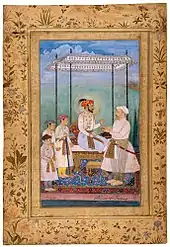
In 1612, aged 20, Khurram married Arjumand Banu Begum, who became known by the title Mumtaz Mahal, on the auspicious date chosen by court astrologers. The marriage was a happy one and Khurram remained devoted to her. She bore him fourteen children, out of whom seven survived into adulthood.
Though there was genuine love between the two, Arjumand Banu Begum was a politically astute woman and served as a crucial advisor and confidante to her husband.[29] Later on, as empress, Mumtaz Mahal wielded immense power, such as being consulted by her husband in state matters and being responsible for the imperial seal, which allowed her to review official documents in their final draft.

Mumtaz Mahal died at age 38 (7 June 1631) while giving birth to Gauhar Ara Begum in Burhanpur. She died of a postpartum haemorrhage, which caused considerable blood-loss after painful labor of thirty hours.[30] Contemporary historians note that Princess Jahanara, aged 17, was so distressed by her mother's pain that she started distributing gems to the poor, hoping for divine intervention, and Shah Jahan was noted as being "paralysed by grief" and weeping fits.[31] Her body was temporarily buried in a walled pleasure garden known as Zainabad, originally constructed by Shah Jahan's uncle Prince Daniyal along the Tapti River. Her death had a profound impact on Shah Jahan's personality and inspired the construction of the Taj Mahal, where she was later reburied.
In the intervening years Khurram had taken other wives, among which are Kandahari Begum (m. 28 October 1610) and Izz un-Nisa Begum (m. 2 September 1617), the daughters of Muzaffar Husain Mirza Safawi and Shahnawaz Khan, son of Abdul Rahim Khan-I-Khana, respectively. But according to court chroniclers, his relationship with his other wives was more out of political consideration, and they enjoyed only the status of being royal wives.[18]
Khurram is also recorded to have married his maternal half-cousin, Lilavati Bai, daughter of Sakat Singh Rathore of Kharwa. The marriage took place when Khurram was in rebellion against his father, Jahangir.[32]
Accusation of Incest
Francois Bernier, a French physician who visited India from 1659 to 1668, records the relationship of Shah Jahan with Jahanara Begum exceeded basic decency that it was rumoured that they were in an incestuous relationship.[33] Similar such claims are also alleged by De laet, Peter Mundy and Tavernier. Based on this Historian Vincent Smith also argues for the same thing. But as Historian B P Saksena shows, there is no support for such a claim.[34] Niccolao Manucci who was a contemporary of Bernier, who otherwise talks freely about the aberrations and love affairs of Jahanara repudiates his charge of incest and says:
She (Jahanara) served him with great diligence and love in order that her father should accede to her petitions (To marry). It was from this cause that the Common people hinted that she had intercourse with her father and this gave occasion to Monsieur Bernier to write a lot of things about this princess, founded entirely on the talks of Low people[35]
Further Manucci also says that what Bernier writes was also untrue. As asserted by Historian K. S. Lal, the rumour was fed by the malice of the courtiers and the verdict of the Mullas. Aurangzeb’s confining of Jahanara in the Agra Fort with the Royal prisoner and the talk of the low people. All these circumstances point to Aurangzeb's involvement in magnifying a rumour into a full-fledged scandal. Right from the beginning the relations between Dara and Aurangzeb were not cordial and Jahanara was a partisan of Dara . During the war of Succession, The nobles and courtiers had been divided into two camps in support of the two princes. When Aurangzeb won the throne the number of his supporters swelled. Mullas were also close to Aurangzeb. It was thus possible that with the verdict of the Maulanas Aurengzeb was seeking to destroy the images of both Shah Jahan and Jahanara at the same time.[36]
Early military campaigns
.jpg.webp)
Prince Khurram showed extraordinary military talent. The first occasion for Khurram to test his military prowess was during the Mughal campaign against the Rajput state of Mewar, which had been a hostile force to the Mughals since Akbar's reign. In December 1613 at an auspicious hour, Prince Khurram was adorned with various, including the and sent to Mewar.[37]
After a year of a harsh war of attrition, Rana Amar Singh I surrendered conditionally to the Mughal forces and became a vassal state of the Mughal Empire.[38] In 1615, Khurram presented Kunwar Karan Singh, Amar Singh's heir to Jahangir. Khurram was sent to pay homage to his mother and stepmothers and was later award by Jahangir.[39] The same year, his mansab was increased from 12000/6000 to 15000/7000, to equal that his brother Parvez's and was further increased to 20000/10000 in 1616.[40][41]
In 1616, on Khurram's departure to Deccan, Jahangir awarded him the title Shah Sultan Khurram.[42]
In 1617, Khurram was directed to deal with the Lodis in the Deccan to secure the Empire's southern borders and to restore imperial control over the region. On his return 1617 after successes in these campaigns, Khurram performed koronush before Jahangir who called him to jharoka and rose from his seat to embrace him. Jahangir also granting him the title of Shah Jahan (Persian: "King of the World")[43] and raised his military rank to 30000/20000 and allowed him a special throne in his Durbar, an unprecedented honor for a prince.[44] Edward S. Holden writes, "He was flattered by some, envied by others, loved by none."[45]
In 1618, Shah Jahan was given the first copy of Jahangirnama by his father who considered him "the first of all my sons in everything."[46]
Rebel prince
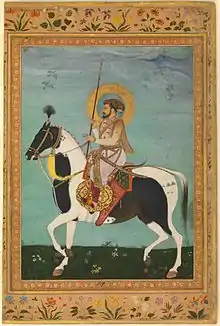
Inheritance of power and wealth in the Mughal Empire was not determined through primogeniture, but by princely sons competing to achieve military successes and consolidating their power at court. This often led to rebellions and wars of succession. As a result, a complex political climate surrounded the Mughal court in Khurram's formative years. In 1611 his father married Nur Jahan, the widowed daughter of a Persian noble. She rapidly became an important member of Jahangir's court and, together with her brother Asaf Khan, wielded considerable influence. Arjumand was Asaf Khan's daughter and her marriage to Khurram consolidated Nur Jahan and Asaf Khan's positions in court.
Court intrigues, however, including Nur Jahan's decision to have her daughter from her first marriage wed Prince Khurram's youngest brother Shahzada Shahryar and her support for his claim to the throne led to much internal division. Prince Khurram resented the influence Nur Jahan held over his father and was angered at having to play second fiddle to her favourite Shahryar, his half-brother and her son-in-law. When the Persians besieged Kandahar, Nur Jahan was at the helm of the affairs. She ordered Prince Khurram to march for Kandahar, but he refused. As a result of Prince Khurram's refusal to obey Nur Jahan's orders, Kandahar was lost to the Persians after a forty-five-day siege.[47] Prince Khurram feared that in his absence Nur Jahan would attempt to poison his father against him and convince Jahangir to name Shahryar the heir in his place. This fear brought Prince Khurram to rebel against his father rather than fight against the Persians.
In 1622, Prince Khurram raised an army and marched against his father and Nur Jahan.[47] He was defeated at Bilochpur in March 1623. Later he took refuge in Udaipur Mewar with Maharana Karan Singh II. He was first lodged in Delwada Ki Haveli and subsequently shifted to Jagmandir Palace on his request. Prince Khurram exchanged his turban with the Maharana and that turban is still preserved in Pratap Museum, Udaipur (R V Somani 1976). It is believed that the mosaic work of Jagmandir inspired him to use mosaic work in the Taj Mahal of Agra. In November 1623, he found safe asylum in Bengal Subah after he was driven from Agra and the Deccan. He advanced through Midnapur and Burdwan. At Akbarnagar, he defeated and killed the then Subahdar of Bengal, Ibrahim Khan Fath-i-Jang, on 20 April 1624.[48] He entered Dhaka and "all the elephants, horses, and 4,000,000 rupees in specie belonging to the Government were delivered to him". After a short stay he then moved to Patna.[49]: 6 His rebellion did not succeed in the end and he was forced to submit unconditionally after he was defeated near Allahabad. Although the prince was forgiven for his errors in 1626, tensions between Nur Jahan and her stepson continued to grow beneath the surface.
Upon the death of Jahangir in 1627, the wazir Asaf Khan, who had long been a quiet partisan of Prince Khurram, acted with unexpected forcefulness and determination to forestall his sister's plans to place Prince Shahryar on the throne. He put Nur Jahan in close confinement. He obtained control of Prince Khurram's three sons who were under her charge. Asaf Khan also managed palace intrigues to ensure Prince Khurram's succession to the throne.[50] Prince Khurram succeeded to the Mughal throne as Abu ud-Muzaffar Shihab ud-Din Mohammad Sahib ud-Quiran ud-Thani Shah Jahan Padshah Ghazi (Urdu: شهاب الدین محمد خرم), or Shah Jahan.[51]
His regnal name is divided into various parts. Shihab ud-Din, meaning "Star of the Faith", Sahib al-Quiran ud-Thani, meaning "Second Lord of the Happy Conjunction of Jupiter and Venus". Shah Jahan, meaning "King of the World", alluding to his pride in his Timurid roots and his ambitions. More epithets showed his secular and religious duties. He was also Khalifat Panahi ("Refuge of the Caliphate"), but Zill-i Allahi, or the "Shadow of God on Earth".
His first act as ruler was to execute his chief rivals and imprison his stepmother Nur Jahan. Upon Shah Jahan's orders, several executions took place on 23 January 1628. Those put to death included his brother Shahryar; his nephews Dawar and Garshasp, sons of Shah Jahan's previously executed brother Prince Khusrau; and his cousins Tahmuras and Hoshang, sons of the late Prince Daniyal Mirza.[52][53] This allowed Shah Jahan to rule his empire without contention.
Reign
Administration of the Mughal Empire
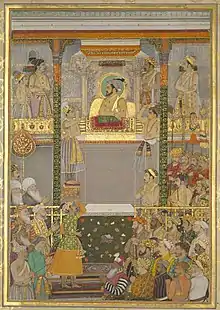
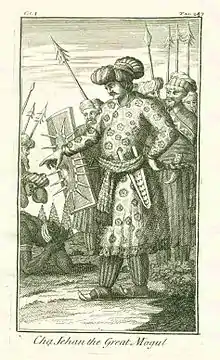

Evidence from the reign of Shah Jahan states that in 1648 the army consisted of 911,400 infantry, musketeers, and artillery men, and 185,000 Sowars commanded by princes and nobles.
His cultural and political initial steps have been described as a type of the Timurid Renaissance, in which he built historical and political bonds with his Timurid heritage mainly via his numerous unsuccessful military campaigns on his ancestral region of Balkh. In various forms, Shah Jahan appropriated his Timurid background and grafted it onto his imperial legacy.[54]
During his reign the Marwari horse was introduced, becoming Shah Jahan's favorite, and various Mughal cannons were mass-produced in the Jaigarh Fort. Under his rule, the empire became a huge military machine and the nobles and their contingents multiplied almost fourfold, as did the demands for more revenue from their citizens. But due to his measures in the financial and commercial fields, it was a period of general stability—the administration was centralized and court affairs systematized.
The Mughal Empire continued to expand moderately during his reign as his sons commanded large armies on different fronts. India at the time was a rich center of the arts, crafts and architecture, and some of the best of the architects, artisans, craftsmen, painters and writers of the world resided in Shah Jahan's empire. According to economist Angus Maddison, Mughal-era India's share of global gross domestic product (GDP) grew from 22.7% in 1600 to 24.4% in 1700, surpassing China to become the world's largest.[55][56] E. Dewick and Murray Titus, quoting Badshahnama, write that 76 temples in Benares were demolished on Shah Jahan's orders.[57]
Famine of 1630
A famine broke out in 1630–32 in Deccan, Gujarat and Khandesh as a result of three main crop failures.[58] Two million died of starvation, grocers sold dogs' flesh and mixed powdered bones with flour. Parents ate their own children. Some villages were completely destroyed, their streets filled with human corpses. In response to the devastation, Shah Jahan set up langar (free kitchens) for the victims of the famine.[59]
Relations with the Deccan Sultanates
In 1632, Shah Jahan captured the fortress at Daulatabad, Maharashtra and imprisoned Husain Shah of the Nizam Shahi Kingdom of Ahmednagar. Golconda submitted in 1635 and then Bijapur in 1636. Shah Jahan appointed Aurangzeb as Viceroy of the Deccan, consisting of Khandesh, Berar, Telangana, and Daulatabad. During his viceroyalty, Aurangzeb conquered Baglana, then Golconda in 1656, and then Bijapur in 1657.[60]
Sikh rebellion led by Guru Hargobind
A rebellion of the Sikhs led by Guru Hargobind took place and in return, Shah Jahan ordered their destruction Although Guru Hargobind Shahib defeated Mughals army in Battle of Amritsar, Battle of Kartarpur, Battle of Rohilla, Battle of Lahira
Relations with the Safavid dynasty
.jpg.webp)
Shah Jahan and his sons captured the city of Kandahar in 1638 from the Safavids, prompting the retaliation of the Persians led by their ruler Abbas II of Persia, who recaptured it in 1649. The Mughal armies were unable to recapture it despite repeated sieges during the Mughal–Safavid War.[61] Shah Jahan also expanded the Mughal Empire to the west beyond the Khyber Pass to Ghazna and Kandahar.
Relations with the Ottoman Empire
Shah Jahan had friendly relations with the Ottomans.[62] While he was encamped in Baghdad, the Ottoman Sultan Murad IV met Shah Jahan's ambassadors, Mir Zarif and Mir Baraka, who presented 1000 pieces of finely embroidered cloth and even armor. Murad IV presented them with the finest weapons, saddles, and Kaftans and ordered his forces to accompany the Mughals to the port of Basra, where they set sail to Thatta and finally Surat.[63]
War with Portuguese
Shah Jahan gave orders in 1631 to Qasim Khan, the Mughal viceroy of Bengal, to drive out the Portuguese from their trading post at Port Hoogly. The post was heavily armed with cannons, battleships, fortified walls, and other instruments of war.[64] The Portuguese were accused of trafficking by high Mughal officials and due to commercial competition the Mughal-controlled port of Saptagram began to slump. Shah Jahan was particularly outraged by the activities of Jesuits in that region, notably when they were accused of abducting peasants. On 25 September 1632, the Mughal Army raised imperial banners and gained control over the Bandel region, and the garrison was punished.[65] On 23 of December 1635, Shah Jahan issued a farman ordering the Agra Church to be demolished. The Church was occupied by the Portuguese Jesuits. However the Emperor allowed the Jesuits to conduct their religious ceremonies in privacy. He also banned the Jesuits in preaching their religion and making converts from both Hindus and Muslims.[66][67]
Ministers
Shah Jahan's treasurer was Sheikh Farid, who founded the city of Faridabad.
Revolts against Shah Jahan
The Kolis of Gujarat were most rebellious under the rule of Shah Jahan. In 1622, Shah Jahan sent Raja Vikramjit who was Governor of Gujarat to subdue the Kolis of Ahmedabad.[68] Between 1632 and 1635, four viceroys were appointed due to they could not manage the Koli activities well. Kolis of Kankrej in North Gujarat committed excesses and the Jam of Nawanagar did not paid the tribute. Soon Azam Khan was appointed who put the province in order by subduing the Kolis. Azam Khan marched against Koli rebels, When Ázam Khán reached Sidhpur, the merchants complained bitterly of the outrages of one Kánji, a Chunvalia Koli, who had been especially daring in plundering merchandise and committing highway robberies. Ázam Khán, anxious to start with a show of vigour, before proceeding to Áhmedábád, marched against Kánji, who fled to the village of Bhádar near Kheralu, sixty miles north-east of Áhmedábád. Ázam Khán pursued him so hotly that Kánji surrendered, handed over his plunder, and gave security not only that he would not again commit robberies, but that he would pay an annual tribute of Rupees 10,000. Ázam Khán then built two fortified posts in the Koli country, naming one Ázamábád after himself, and the other Khalílábád after his son and He also made the Jam of Nawanagar surrender.[69] The next viceroy Ísa Tarkhán carried out financial reforms. In 1644, the Mughal prince Aurangzeb was appointed as the viceroy who was engaged in religious disputes for destroying a Jain temple in Ahmedabad. Due to his disputes, he was replaced by Shaista Khan who failed to subdue Kolis. So the prince Murad Bakhsh was appointed as the viceroy in 1654. He restored the disorder soon and defeated the Koli rebels.[70]
Illness and death
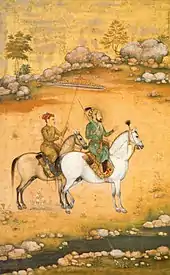
When Shah Jahan became ill in 1658, Dara Shikoh (Mumtaz Mahal's eldest son) assumed the role of regent in his father's stead, which swiftly incurred the animosity of his brothers.[71] Upon learning of his assumption of the regency, his younger brothers, Shuja, Viceroy of Bengal, and Murad Baksh, Viceroy of Gujarat, declared their independence and marched upon Agra in order to claim their riches. Aurangzeb, the third son, gathered a well-trained army and became its chief commander. He faced Dara's army near Agra and defeated him during the Battle of Samugarh.[72] Although Shah Jahan fully recovered from his illness, Aurangzeb declared him incompetent to rule and put him under house arrest in Agra Fort.
Jahanara Begum Sahib, Mumtaz Mahal's eldest surviving daughter, voluntarily shared his 8-year confinement and nursed him in his dotage. In January 1666, Shah Jahan fell ill. Confined to bed, he became progressively weaker until, on 30 January, he commended the ladies of the imperial court, particularly his consort of later years Akbarabadi Mahal, to the care of Jahanara. After reciting the Kal'ma (Laa ilaaha ill allah) and verses from the Quran, Shah Jahan died, aged 74.
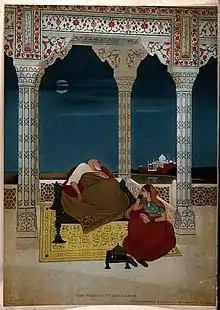
Shah Jahan's chaplain Sayyid Muhammad Qanauji and Kazi Qurban of Agra came to the fort, moved his body to a nearby hall, washed it, enshrouded it, and put it in a coffin of sandalwood.[29]
Princess Jahanara had planned a state funeral which was to include a procession with Shah Jahan's body carried by eminent nobles followed by the notable citizens of Agra and officials scattering coins for the poor and needy. Aurangzeb refused to accommodate such ostentation. The body was taken to the Taj Mahal and was interred there next to the body of his beloved wife Mumtaz Mahal.[73]
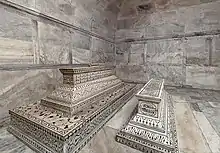
Contributions to architecture
Shah Jahan left behind a grand legacy of structures constructed during his reign. He was one of the greatest patrons of Mughal architecture.[74] His reign ushered in the golden age of Mughal architecture.[75] His most famous building was the Taj Mahal, which he built out of love for his wife, the empress Mumtaz Mahal. His relationship with Mumtaz Mahal has been heavily adapted into Indian art, literature and cinema. Shah Jahan personally owned the royal treasury, and several precious stones such as the Kohinoor.
Its structure was drawn with great care and architects from all over the world were called for this purpose. The building took twenty years to complete and was constructed from white marble underlaid with brick. Upon his death, his son Aurangzeb had him interred in it next to Mumtaz Mahal. Among his other constructions are the Red Fort also called the Delhi Fort or Lal Qila in Urdu, large sections of Agra Fort, the Jama Masjid, the Wazir Khan Mosque, the Moti Masjid, the Shalimar Gardens, sections of the Lahore Fort, the Mahabat Khan Mosque in Peshawar, the Mini Qutub Minar[76] in Hastsal, the Jahangir mausoleum—his father's tomb, the construction of which was overseen by his stepmother Nur Jahan and the Shahjahan Mosque. He also had the Peacock Throne, Takht e Taus, made to celebrate his rule. Shah Jahan also placed profound verses of the Quran on his masterpieces of architecture.
The Shah Jahan Mosque in Thatta, Sindh province of Pakistan (100 km / 60 miles from Karachi) was built during the reign of Shah Jahan in 1647. The mosque is built with red bricks with blue coloured glaze tiles probably imported from another Sindh's town of Hala. The mosque has overall 93 domes and it is the world's largest mosque having such a number of domes. It has been built keeping acoustics in mind. A person speaking inside one end of the dome can be heard at the other end when the speech exceeds 100 decibels. It has been on the tentative UNESCO World Heritage list since 1993.[77]
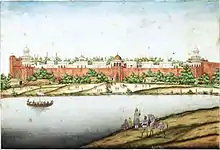
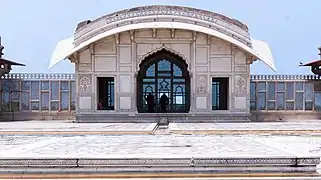 The elegant Naulakha Pavilion at the Lahore Fort was built during the reign of Shah Jahan.
The elegant Naulakha Pavilion at the Lahore Fort was built during the reign of Shah Jahan.
 Shah Jahan and the Mughal Army return after attending a congregation in the Jama Masjid, Delhi.
Shah Jahan and the Mughal Army return after attending a congregation in the Jama Masjid, Delhi.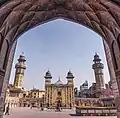 Lahore's Wazir Khan Mosque is considered to be the most ornate Mughal-era mosque.[78]
Lahore's Wazir Khan Mosque is considered to be the most ornate Mughal-era mosque.[78] Moti Masjid (Red Fort)
Moti Masjid (Red Fort)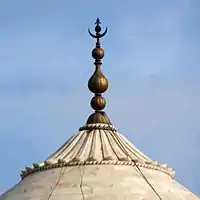 Finial, Tamga of the Mughal Empire (combining a crescent and a spear pendant with the word Allah).
Finial, Tamga of the Mughal Empire (combining a crescent and a spear pendant with the word Allah).
Coins
Shah Jahan continued striking coins in three metals i.e. gold (mohur), silver (rupee) and copper (dam). His pre-accession coins bear the name Khurram.
 Gold Mohur from Akbarabad (Agra)
Gold Mohur from Akbarabad (Agra) Silver rupee coin of Shah Jahan, from Patna.
Silver rupee coin of Shah Jahan, from Patna. Copper Dam from Daryakot mint
Copper Dam from Daryakot mint Silver Rupee from Multan
Silver Rupee from Multan
| Styles of Shah Jahan | |
|---|---|
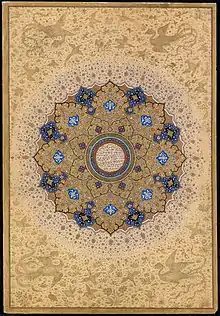 | |
| Reference style | Shahanshah |
| Spoken style | His Imperial Majesty |
| Alternative style | Alam Pana |
Issue
| Name | Portrait | Lifespan | Notes |
|---|---|---|---|
| Parhez Banu Begum | 21 August 1611 - 1675 |
Shah Jahan's first child born to his first wife, Kandahari Begum. Parhez Banu was her mother's only child and died unmarried. | |
| Hur-ul-Nisa Begum | 30 March 1613 - 5 June 1616 |
The first of fourteen children born to Shah Jahan's second wife, Mumtaz Mahal. She died of smallpox at the age of 3.[79] | |
| Jahanara Begum Padshah Begum |
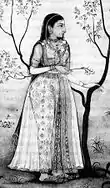 |
23 March 1614 - 16 September 1681 |
Shah Jahan's favourite and most influential daughter. Jahanara became the First Lady (Padshah Begum) of the Mughal Empire after her mother's death, despite the fact that her father had three other consorts. She died unmarried. |
| Dara Shikoh Padshahzada-i-Buzurg Martaba, Jalal ul-Kadir, Sultan Muhammad Dara Shikoh, Shah-i-Buland Iqbal |
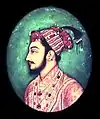 |
20 March 1615 - 30 August 1659 |
The eldest son and heir-apparent. He was favoured as a successor by his father, Shah Jahan, and his elder sister, Princess Jahanara Begum, but was defeated and later killed by his younger brother, Prince Muhiuddin (later the Emperor Aurangzeb), in a bitter struggle for the imperial throne. He married and had an issue. |
| Shah Shuja | .jpg.webp) |
23 June 1616 - 7 February 1661 |
He survived in the war of succession. He married and had an issue. |
| Roshanara Begum Padshah Begum |
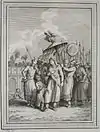 |
3 September 1617 - 11 September 1671 |
She was the most influential of Shah Jahan's daughters after Jahanara Begum and sided with Aurangzeb during the war of succession. She died unmarried. |
| Aurangzeb Mughal emperor |
 |
3 November 1618 - 3 March 1707 |
Succeeded his father as the sixth Mughal emperor after emerging victorious in the war of succession that took place after Shah Jahan's illness in 1657. |
| Jahan Afroz | 25 June 1619 - March 1621 |
The only child of Shah Jahan's third wife, Izz-un-Nissa (titled Akbarabadi Mahal). Jahan Afroz died at the age of one year and nine months.[80] | |
| Izad Bakhsh | 18 December 1619 - February/March 1621[81] |
Died in infancy. | |
| Surayya Banu Begum | 10 June 1621 - 28 April 1628[81] |
Died of smallpox at the age of 7.[79] | |
| Unnamed son | 1622 | Died soon after birth.[81] | |
| Murad Bakhsh | 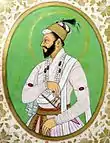 |
8 October 1624 - 14 December 1661 |
He was killed in 1661 as per Aurangzeb's orders.[79] He married and had issue. |
| Lutf Allah | 4 November 1626 - 13 May 1628[81] |
Died at the age of one and a half years.[79] | |
| Daulat Afza | 8 May 1628 - 13 May 1629[82] |
Died in infancy. | |
| Husnara Begum | 23 April 1629 - 1630[81] |
Died in infancy. | |
| Gauhara Begum | 17 June 1631 - 1706 |
Mumtaz Mahal died while giving birth to her on 17 June 1631 in Burhanpur. She died unmarried. | |
| Purhanara Begum | died After 1666 | ? | |
| Nazarara Begum | ? | ? |
See also
- Shah Jahan II
- Shah Jahan III
- Wine cup of Shah Jahan
References
Notes
- Shujauddin, Mohammad; Shujauddik, Razia (1967). The Life and Times of Noor Jahan. Lahore: Caravan Book House. p. 121. OCLC 638031657.
- Necipoğlu, Gülru, ed. (1994). Muqarnas : an annual on Islamic art and architecture. Vol. 11. Leiden, Netherlands: E.J. Brill. p. 143. ISBN 978-90-04-10070-1.
- Fenech, Louis E. (2014). "The Evolution of the Sikh Community". In Singh, Pashaura; Fenech, Louis E. (eds.). The Oxford Handbook of Sikh Studies. Oxford University Press. p. 46. ISBN 978-0-19-969930-8.
Jahangir’s son, ponkua, better known as the emperor Shah Jahan
- Singh, Pashaura; Fenech, Louis E., eds. (2014). "Index". The Oxford Handbook of Sikh Studies. Oxford University Press. p. 649. ISBN 978-0-19-969930-8.
Shah Jahan, Emperor Shahabuddin Muhammad Khurram
- Flood, Finbarr Barry; Necipoglu, Gulru (2017). A Companion to Islamic Art and Architecture. John Wiley & Sons. p. 897. ISBN 978-1-119-06857-0.
- Illustrated dictionary of the Muslim world. Tarrytown, NY: Marshall Cavendish Reference. 2011. p. 136. ISBN 978-0-7614-7929-1.
- Richards 1993, Shah Jahan, pp. 121–122.
- "Shah Jahan". Encyclopædia Britannica.
- Findly 1993, p. 125
- Jahangir (1999). The Jahangirnama: Memoirs of Jahangir, Emperor of India. Translated by Thackston, W. M. Oxford University Press. p. 30. ISBN 0-19-512718-8.
- Eraly 2000, p. 299
- Jahangir (1999). The Jahangirnama: Memoirs of Jahangir, Emperor of India. Translated by Thackston, W. M. Oxford University Press. p. 46. ISBN 0-19-512718-8.
- Kamboh, Muhammad Saleh. Amal I Salih.
During her stay at Fatehpur, the mother of Shah Jahan, Hazrat Bilqis Makani, a resident of Agra became ill. The treatment did not work. Finally, on 4th Jamadi-ul-Awal, she passed away and according to her will, she was buried at Dehra Bagh, near Noor Manzil.
- Perston, Diana; Perston, Micheal. A Teardrop on the Cheek of Time: The Story of the Taj Mahal.
Although removed from his mother at birth, Shah Jahan had become devoted to her.
- Lal, Muni (1986). Shah Jahan. Vikas Publishing House. p. 52.
- Banarsi Prasad Saksena (1932). History Of Shahjahan Of Dihli 1932. Indian Press Limited.
- Saiyada Asad Alī (2000). Influence of Islam on Hindi Literature. Idarah-i-Adabiyat-Delli. p. 48.
- Qazvini, Asad Beg; Mughal-era historian
- Prasad 1930, p. 189 "During his grandfather's last illness, he [Khurram] refused to leave the bedside surrounded by his enemies. Neither the advice of his father nor the entreaties of his mother could prevail on him to prefer the safety of his life to his last duty to the old man."
- Nicoll 2009, p. 49
- Faruqui, Munis D. (2012). The Princes of the Mughal Empire, 1504–1719. Cambridge University Press. p. 71. ISBN 978-1-107-02217-1.
- Nicoll 2009, p. 56
- Emperor, Jahangir (1999). The Jahangirnama. Freer Gallery of Art, Arthur M. Sackler Gallery, Smithsonian Institution and Oxford University Press. pp. 61. ISBN 9780195127188.
- Emperor, Jahangir (1999). The Jahangirnama. Freer Gallery of Art, Arthur M. Sackler Gallery, Smithsonian Institution and Oxford University Press. pp. 84. ISBN 9780195127188.
- Emperor, Jahangir (1999). The Jahangirnama. Freer Gallery of Art, Arthur M. Sackler Gallery, Smithsonian Institution and Oxford University Press. pp. 81. ISBN 9780195127188.
- Prasad 1930, p. 190 "Khusrau conspired, rebelled, and lost the favour of his father ... Of all the sons of Jahangir, Khurram was marked out to be the heir-apparent and successor ... In 1608 the assignment of the sarkar of Hissar Firoz to him proclaimed to the world that he was intended for the throne.
- Nicoll 2009, p. 66
- Eraly 2000, p. 300
- Eraly 2000, p. 379
- Kumar, Anant (January–June 2014). "Monument of Love or Symbol of Maternal Death: The Story Behind the Taj Mahal". Case Reports in Women's Health. 1: 4–7. doi:10.1016/j.crwh.2014.07.001. Retrieved 21 December 2015.
- Nicoll 2009, p. 177
- The Mertiyo Rathors of Merta, Rajasthan. Vol. II. p. 45.
- Constable, Archibald, ed. (1916), "Begum Saheb", Travels in Mogul India, Oxford University Press, p. 11
- Saksena, ed. (1932), "The Charge of Incest", History of Shahjahan of Dihli, The Indian press ltd, Allahabad, p. 339
- Irvine, William, ed. (1907), "Begum Saheb", Storia Do Mogor Vol 1, Oxford University press, pp. 216–217.
- Lal, Kishori Saran, ed. (1988), "The Charge of Incest", The Mughal Harem, Adithya Prakashan, pp. 93–94
- Emperor, Jahangir (1999). The Jahangirnama. Freer Gallery of Art, Arthur M. Sackler Gallery, Smithsonian Institution and Oxford University Press. pp. 154. ISBN 9780195127188.
- Prasad 1930, p. 239 "Constant skirmishes were thinning the Rajput ranks ... [Amar Singh] offered to recognize Mughal supremacy ... Jahangir gladly and unreservedly accepted the terms."
- Emperor, Jahangir (1999). The Jahangirnama. Freer Gallery of Art, Arthur M. Sackler Gallery, Smithsonian Institution and Oxford University Press. pp. 116. ISBN 9780195127188.
- Emperor, Jahangir (1999). The Jahangirnama. Freer Gallery of Art, Arthur M. Sackler Gallery, Smithsonian Institution and Oxford University Press. pp. 175. ISBN 9780195127188.
- Emperor, Jahangir (1999). The Jahangirnama. Freer Gallery of Art, Arthur M. Sackler Gallery, Smithsonian Institution and Oxford University Press. pp. 192. ISBN 9780195127188.
- Emperor, Jahangir (1999). The Jahangirnama. Freer Gallery of Art, Arthur M. Sackler Gallery, Smithsonian Institution and Oxford University Press. pp. 201. ISBN 9780195127188.
- Middleton, John (2015). World Monarchies and Dynasties. Routledge. p. 451. ISBN 978-1-317-45158-7.
- Emperor, Jahangir (1999). The Jahangirnama. Freer Gallery of Art, Arthur M. Sackler Gallery, Smithsonian Institution and Oxford University Press. pp. 228-29. ISBN 9780195127188.
- Holden, Edward S. (2004) [First published 1895]. Mughal Emperors of Hindustan (1398–1707). New Delhi, India: Asian Educational Service. p. 257. ISBN 978-81-206-1883-1.
- Emperor, Jahangir (1999). The Jahangirnama. Freer Gallery of Art, Arthur M. Sackler Gallery, Smithsonian Institution and Oxford University Press. pp. 271. ISBN 9780195127188.
- Satish Chandra (2007). History of Medieval India: 800-1700. Orient BlackSwan. ISBN 978-8125032267. Retrieved 24 September 2020.
- Muazzam Hussain Khan (2012). "Ibrahim Khan Fath-i-Jang". In Islam, Sirajul; Miah, Sajahan; Khanam, Mahfuza; Ahmed, Sabbir (eds.). Banglapedia: the National Encyclopedia of Bangladesh (Online ed.). Dhaka, Bangladesh: Banglapedia Trust, Asiatic Society of Bangladesh. ISBN 984-32-0576-6. OCLC 52727562. Retrieved 25 October 2022.
- Hossain, Syud (1909). Echoes from Old Dacca. Edinburgh Press.
- Richards 1993, p. 117
- Nicoll 2009, p. 157
- Elliot, H. M. (1867–1877). The History of India, as Told by Its Own Historians. Vol. VI. London.
- Findly 1993, pp. 275–282, 284
- Sufism and Society: Arrangements of the Mystical in the Muslim World, 1200–1800 edited by John Curry, Erik Ohlander, Page 141
- Maddison, Angus (2006). The World Economy Volumes 1–2. Development Center of the Organisation for Economic Co-operation and Development. p. 639. doi:10.1787/456125276116. ISBN 92-64-02261-9.
- Matthews, Chris (5 October 2014). "The 5 most dominant economic empires of all time". Fortune. Retrieved 18 August 2016.
- Titus, Murray T; Dewick, E.C. (1979). Indian Islam. Delhi: Munshiram Manoharlal Publishers. p. 24. ISBN 978-8170690962.
- Ó Gráda, Cormac (March 2007). "Making Famine History". Journal of Economic Literature. 45 (1): 5–38. doi:10.1257/jel.45.1.5. hdl:10197/492. JSTOR 27646746. S2CID 54763671.
Well-known famines associated with back-to-back harvest failures include ... the Deccan famine of 1630–32
- Mahajan, Vidya Dhar (1971) [First published in 1961]. Mughal Rule in India (10th ed.). Delhi: S. Chand. pp. 148–149. OCLC 182638309.
- Sen 2013, pp. 170–171
- Sen 2013, pp. 169–170
- M. P. Srivastava (1978). Policies of the Great Mughals. the University of Michigan. p. 168.
- Farooqi, N. R. (1989). Mughal-Ottoman Relations: A Study of Political & Diplomatic Relations Between Mughal India and the Ottoman Empire, 1556–1748. Idarah-i Adabiyat-i Delli. OCLC 20894584.
- Ikram, S. M. (1964). Muslim Civilization in India. Columbia University Press. pp. 175–188. ISBN 978-0-231-02580-5 – via Frances W. Pritchett.
- Duiker, William J.; Spielvogel, Jackson J. (2006). World History: From 1500. Cengage Learning. pp. 431, 475. ISBN 978-0-495-05054-4.
- Sharma, Ram, ed. (1962), "Shah Jahan", The Religious policy of the Mughal Emperors, Asian publishing house, pp. 104–105
- "Farman of Shah Jahan".
- Behera, Maguni Charan (9 November 2019). Tribal Studies in India: Perspectives of History, Archaeology and Culture. New Delhi, India: Springer Nature. p. 46. ISBN 978-981-329-026-6.
{{cite book}}: CS1 maint: date and year (link) - Campbell 1896, pp. 279.
- Ashburner, Bhagvánlál Indraji (1839-1888) John Whaley Watson (1838–1889) Jervoise Athelstane Baines (1847–1925) L. R. "History of Gujarát". www.gutenberg.org. pp. 278–283. Retrieved 16 October 2022.
- Gonzalez, Valerie (2016). Aesthetic Hybridity in Mughal Painting, 1526–1658. Routledge. p. 116. ISBN 978-1-317-18487-4.
- Richards 1993, p. 158
- ASI, India. "Taj Mahal". asi.nic.in. Archeological Survey of India. Retrieved 8 December 2018.
- Asher 2003, p. 169
- Mehta, Jaswant Lal (1984) [First published 1981]. Advanced Study in the History of Medieval India. Vol. II (2nd ed.). Sterling Publishers Pvt. Ltd. p. 59. ISBN 978-81-207-1015-3. OCLC 1008395679.
- "A Qutub Minar that not many knew even existed". The Times of India. Retrieved 21 September 2018.
- Shah Jahan Mosque UNESCO World Heritage Centre Retrieved 10 February 2011
- Dani, A. H. (2003). "The Architecture of the Mughal Empire (North-Western Regions)" (PDF). In Adle, Chahryar; Habib, Irfan (eds.). History of Civilizations of Central Asia. Vol. V. UNESCO. p. 524. ISBN 978-92-3-103876-1.
- Moosvi, Shireen (2008). People, Taxation, and Trade in Mughal India. Oxford: Oxford University Press. p. 115. ISBN 978-0-19-569315-7.
- Jahangir (1999). The Jahangirnama: Memoirs of Jahangir, Emperor of India. Translated by Thackston, W. M. Oxford University Press. p. 362. ISBN 0-19-512718-8.
[March 1621 - March 1622] Shah-Shuja escaped the brink of death, and another son born of Shahnawaz Khan's daughter [Izz un-Nisa Begum] in Burhanpur died.
- Sarker, Kobita (2007). Shah Jahan and his paradise on earth : the story of Shah Jahan's creations in Agra and Shahjahanabad in the golden days of the Mughals. Kolkata: K.P. Bagchi & Co. p. 40. ISBN 978-8170743002.
- Begley, W. E.; Desai, Z.A., eds. (1989). Taj Mahal: The Illumined Tomb: An Anthology of Seventeenth-Century Mughal and European Documentary Sources. Cambridge, Massachusetts: Aga Khan Program for Islamic Architecture. p. 23. ISBN 978-0-295-96944-2.
Bibliography
- Asher, Catherine Ella Blanshard (2003) [First published 1992]. Architecture of Mughal India. The New Cambridge History of India. Vol. I:4. Cambridge University Press. p. 368. ISBN 978-0-521-26728-1.
- Eraly, Abraham (2000). Emperors of the Peacock Throne: The Saga of the Great Mughals. Penguin Books India. ISBN 978-0-14-100143-2.
- Findly, Ellison Banks (1993). Nur Jahan: Empress of Mughal India. Oxford University Press. ISBN 978-0-19-536060-8.
- Koch, Ebba (2006). The Complete Taj Mahal: And the Riverfront Gardens of Agra. London: Thames & Hudson Ltd. ISBN 978-0-500-34209-1.
- Nicoll, Fergus (2009). Shah Jahan: The Rise and Fall of the Mughal Emperor. London: Haus. ISBN 978-1-906598-18-1.
- Prasad, Beni (1930) [First published 1922]. History of Jahangir (Second ed.). Allahabad: The Indian Press.
- Richards, John F. (1993). The Mughal Empire. The New Cambridge History of India. Vol. V. Cambridge University Press. ISBN 978-0-521-56603-2.
- Sen, Sailendra (2013). Textbook of Medieval Indian History. Primus Books. ISBN 978-93-80607-34-4.